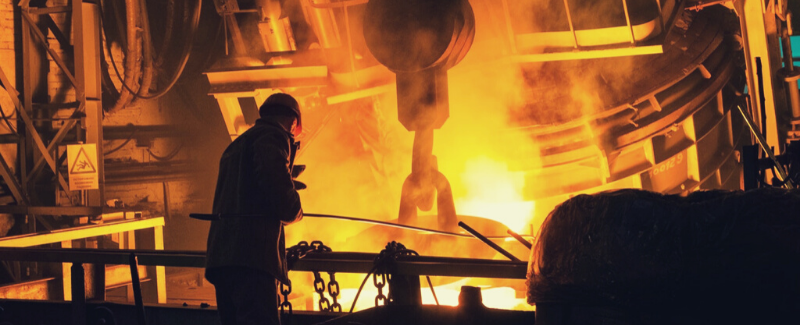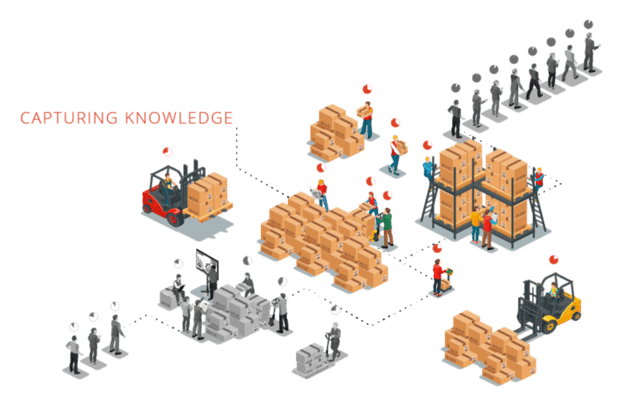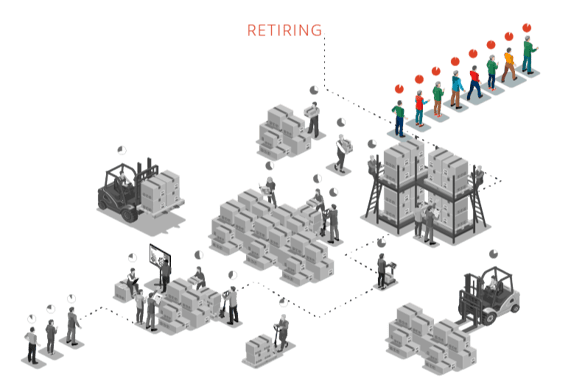
Training
7 min read
Breaking Down the Skills Gap: Tribal Knowledge

As the skills gap widens and more employees retire, decades of experience and company investment is predicted to walk out the door. With nearly ten thousand people turning retirement age daily, manufacturers will need to look towards proactive solutions to capture tribal knowledge and transfer it to the incoming workforce.
While every industry is inherently dependent on the knowledge of its workforce, none may be quite so reliant as the modern manufacturer. Where the unexpected can occur suddenly and the planned must be delivered to exacting standards, the knowledge of a seasoned operator can be invaluable when preventing downtime or rework.
Why then, in the face of a retiring workforce, are companies still failing to capture this knowledge they’ve so heavily invested in — before it walks out the door?
The Dangers of Lost Tribal Knowledge
In the manufacturing environment, meeting standards while overcoming the unexpected is a rare skill held by only by the most experienced workers — the gatekeepers of tribal knowledge. These are the workers who don’t just plug holes in the dam, they recall every attempt, result, and why the current standard exists.
When a problem arises, they know exactly what to do.
More often in the factory environment, tenured workers who were part of the ‘original crew’ and know everything about the operation are still on-staff and available to solve problems or train others. New hires, apprentices, journeymen, management — all rely on their know-how.
Small problems become major obstacles when they’re not around; and yet, the business operates as if they always will be.
Work experience like this is not only an intangible asset but one of a manufacturer’s strongest competitive advantages. In most companies, these gatekeepers gained their expertise as a consequence of hands-on experience, outside of formal training programs.
When these employees leave, they will take all of their expertise with them. This is why that in the face of a massive job skills shortage, companies should work to understand where their tribal knowledge is hidden and seek to capture it
"Without access to this knowledge workers face stressful trial-and-error scenarios; leading to increased overtime, downtime, and cycle time."
Without access to this knowledge, new and poorly trained workers face stressful trial-and-error scenarios — leading to increased overtime, downtime, and cycle time. A situation that perpetuates attrition of new-hires and is nearly impossible to stop through recruitment alone.
Reasons Why Knowledge Goes Uncaptured
As more companies gain awareness of this issue and more experienced employees retire, the push for knowledge capture is quickly becoming a top initiative. Yet, even with a concerted effort to capture tribal knowledge, it can be a significant struggle to make headway in this process. Understanding the common reasons why knowledge goes uncaptured can help you identify where valuable knowledge is hidden.
Job security
Many workers share the sentiment that they’re scared to document themselves out of their job. By being the only person who knows how to do something, the feeling of job security and esteem is increased. Some workers would rather be relied on as the expert, instead of sharing their expertise and risk becoming less integral to the operation.
Workarounds are “bad”
People naturally find workarounds in their daily operations. However, this often means that the work isn’t being “done by the book.” If a company doesn’t embrace a continuous improvement culture, workers will often keep these shortcuts a secret to avoid penalty.
"IT IS NOT ENOUGH TO DO YOUR BEST;YOU MUST KNOW WHAT TO DO AND THEN DO YOUR BEST."
- W. EDWARDS DEMING
Time investment
Thoroughly documenting the expertise of a workforce and turning it into a skilled training program is no small order. If you’re building a 3-5 year training program, don’t be surprised if a time investment of 3-5 years in knowledge capture is required.
Personality type
Many of your in-house experts have spent the past 10-30 years accumulating knowledge without a need to document it. Nor have they been asked to or shown an easy way to do it. Quite simply, your gatekeepers aren’t necessarily best suited for the job of documenting.
No Apprentice
Many times, a lack of formal apprenticeship programs prevents valuable tribal knowledge from being transferred. If there is no apprentice to pair with your expert, the likelihood of that expert’s tribal knowledge being documented is reduced significantly.
Capturing Tribal Knowledge
All this said, the value of these workers is not being overlooked. In fact, most companies go out of their way to recognize their expertise. However, the idea of somehow capturing their knowledge in a way that can be shared throughout the organization is an afterthought.
“I wish I knew how Paul used to get the chatter out of this old CNC machine.”
How do you capture the questions or concerns that lead you to follow an obscure procedure in the first place? Most companies don’t.
"It's here, at the crossroads of outgoing experts and incoming digital natives, where companies can see success capturing outgoing knowledge."
Conveniently, the incoming workforce is thoroughly skilled in digital user interfaces -- spending endless waking off-hours on their personal mobile devices. These “digital natives” expect all of their learning and training to take place through a screen.
It’s here, at the crossroads of outgoing experts and incoming digital natives, where companies can see success capturing outgoing knowledge. Manufacturers must lean into technical solutions to capture the knowledge of retiring workers while engaging and efficiently training the next generations of manufacturers.
To learn more practical tips for how to capture tribal knowledge and address the skills gap in your business, download our free e-book, "Solving the Skills Gap on the Factory Floor."
Topic(s):
Training
Related Posts
View All Posts
Training
Why HR Shouldn't Manage Your Technical Skills Training
6 min read
Amid the Silver Tsunami, HR departments are hustling to onboard and fill personnel gaps, but they can’t predict the evolving demands of your operations. Manufacturing...
Continue Reading
Training
I Got 99 Problems, But Skills Ain’t One
5 min read
How many of your frontline manufacturing workers are engaged, productive, and feel a sense of ownership in their process? Manufacturing Digital recently reported that...
Continue Reading
Training
Why Sharepoint Fails at Knowledge Management
5 min read
Many industrial businesses rely on generic document management tools, like Microsoft Sharepoint, to store and share files. As a document management strategy, this makes...
Continue Reading




